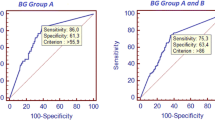Abstract
A technique was developed for separating total serum pentitols into individual arabinitol, adonitol and xylitol and determining their relevance for the diagnosis of disseminated candidiasis. Pentitols were separated as trimethylsilyl derivatives on two 25 m long, bonded methyl silicone columns with a 0.32 mm i. d., and quantified by selected ion monitoring of their protonated molecular ions obtained in chemical ionization. The 173 samples studied were divided into culture-positive, culture-negative, and no-culture groups. Twelve percent of all samples were false positives by the total pentitols method due to increased adonitol and/or xylitol. The continued use of the total pentitols method is, nevertheless, recommended because of its convenience; however, samples with increased total pentitols (and normal creatinine) should be reanalyzed for individual pentitols. Increased arabinitol and normal creatinine are indicative of candidiasis even when blood cultures are negative.
Similar content being viewed by others
References
Kiehn, T., Bernard, E., Gold, J., Armstrong, D.: Candidiasis: detection by gas-liquid chromatography of D-arabinitol, a fungal metabolite, in human serum. Science 1979,206: 577–580.
Roboz, J., Suzuki, R., Holland, J. F.: Quantification of arabinitol in serum by selected ion monitoring as a diagnostic technique in invasive candidiasis. Journal of Clinical Microbiology 1980, 12: 594–602.
Gold, J., Wong, B., Bernard, E., Kiehn, T., Armstrong, D.: Serum arabinitol concentrations and arabinitol/creatinine ratios in invasive candidiasis. Journal of Infectious Diseases 1983, 147: 504–513.
Roboz, J., Kappatos, D., Holland, J. F.: Diagnosis and monitoring of disseminated candidiasis using serum arabinitol concentrations. Cancer Research 1987, 28: 224.
Eng, R., Chmel, H., Buse, M.: Serum levels of arabinitol in the detection of invasive candidiasis in animals and humans. Journal of Infectious Diseases 1981, 143: 677–683.
Deacon, A.: Estimations of serum arabinitol for diagnosing invasive candidiasis. Journal of Clinical Pathology 1986, 39: 842–850.
DeRepentigny, L., Kuykendall, R., Chandler, F., Broderson, R., Reiss, E.: Comparison of serum mannan, arabinitol, and mannose in experimental disseminated candidiasis. Journal of Clinical Microbiology 1984, 19: 804–812.
DeRepentigny, L., Man, L., Keller, J., Carter, A., Kuykendall, R., Kaufman, L., Reiss, E.: Comparison of enzyme immunoassay and gas-liquid chromatography for the rapid diagnosis of invasive candidiasis in cancer patients. ournal of Clinical Microbiology 1095, 21: 972–979.
Pitkanen, E.: The serum polyol pattern and the urinary polyol excretion in diabetic and uremic patients. Clinica Chimica Acta 1972, 38: 221–230.
Roboz, J., Kappatos, D., Greaves, J., Holland, J. F.: Determination of polyols in serum by selected ion monitoring. Clinical Chemistry 1984, 30: 1611–1615.
Bernard, E., Wong, B., Armstrong, D.: Stereoisomeric configuration of arabinitol in serum, urine, and tissues in invasive candidiasis. Journal of Infectious Diseases 1985, 151:711–715.
Myerowitz, R., Pazin, G., Allen, C.: Disseminated candidiasis: changes in incidence, underlying diseases, and pathology. American Journal of Clinical Pathology 1977, 68: 29–38.
Maksymiuk, A., Thorngprasert, S., Hopfer, R., Luna, M., Fainsteins, V., Bodey, G.: Systemic candidiasis in cancer patients. American Journal of Medicine 1984, 77 (4D): 20–27.
Kozinn, P., Taschdjian, C.: Laboratory diagnosis of candidiasis. In: Bodey, G., Fainstein, V. (ed.): Candidiasis. Raven Press, New York, 1985, p. 85–110.
Veiga, L.: Polyol dehydrogenase inCandida albicans. I. Reduction of D-xylose to xylitol. Journal of General and Applied Microbiology 1968, 14: 65–78.
Bernard, E., Christiansen, K., Tsang, S., Kiehn, T., Armstrong, D.: Rate of arabinitol production by pathogenic yeast species. Journal of Clinical Microbiology 1981, 14: 189–194.
Author information
Authors and Affiliations
Rights and permissions
About this article
Cite this article
Roboz, J., Kappatos, D.C. & Holland, J.F. Role of individual serum pentitol concentrations in the diagnosis of disseminated visceral candidiasis. Eur. J, Clin. Microbiol. 6, 708–714 (1987). https://doi.org/10.1007/BF02013083
Issue Date:
DOI: https://doi.org/10.1007/BF02013083




